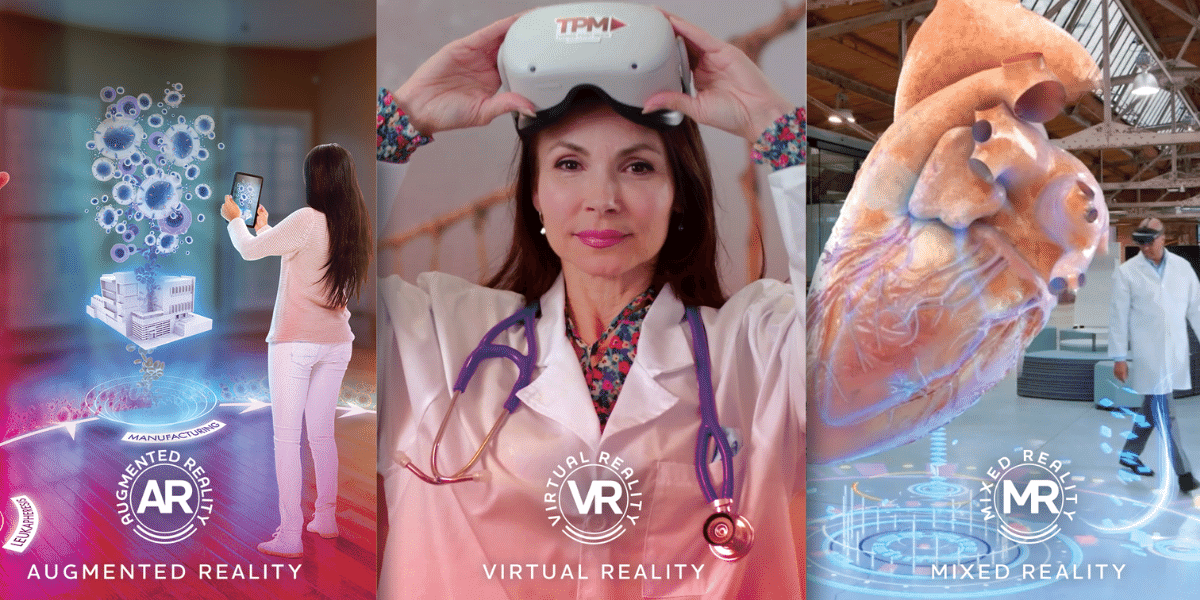Extended reality (XR) is quickly gaining popularity in the medical and pharmaceutical industries since it allows learners to participate actively in their learning. The technology combines mixed, virtual, and augmented reality to provide a low-risk, interactive, and scenario-based learning experience. 3D experiential medical education goes beyond conventional didactic learning.
Let’s explore how XR is changing experiential education for the better.
What is Extended Reality?
XR utilizes mixed realities, VR and AR, to generate immersive environments where learners can visualize ideas and interactively acquire novel skills. These technologies enhance sales training and education by making learning an exciting and engaging experience for learners. XR applications can run on optimized devices such as XR glasses, tablets, and smartphones.
Primary Benefits of XR in Sales Training and Education
1. Increased Employee Retention
Unlike conventional didactic learning, XR experiential education allows learners to participate actively in learning. Engaged employees typically have higher retention rates.
2. Visualization
XR technology generates 3D images designed to instruct employees visually. 3D experiential medical education enables learners to gain insights into processes, concepts, and objects by experiencing them.
In the pharmaceutical industry, an XR application can facilitate illustrative training by showing the effects of different pharmaceutical products on specific organs. XR-generated animated sequences allow healthcare professionals and learners to comprehend the benefits of novel pharmaceutical products. Employees can then use this knowledge to explain to patients and clients how specific treatments work.
XR also enables learners to test the sizeable medical equipment in a simulated environment. Doing so allows companies to save costly training and shipping costs and gives employees a hands-on experience before purchasing the equipment.
3. Advanced Analytics
Different sensors can complement XR technology to facilitate gathering various learners’ metrics, including voice recognition, behavioral data, eye tracking, gestures, and heat maps. Such extensive systems can assess the efficacy of XR-enabled learning. For instance, pupil dilation indicates that a specific aspect of an XR-enabled training program does not engage a learner.
4. Remote Learning
XR technology allows for remote collaboration, for instance, when executing group projects. The immersive technology provides a sense of presence similar to physical interactions. XR-enabled interactions are also more effective than video conferencing, emailing, or chatting.
5. Knowledge Retention
Training programs incorporating XR are more engaging and gratifying for learners since they resemble a game. Some XR-enabled training programs include video game components. For instance, XR-enabled sales training programs in the pharmaceutical industry may allow learners to earn points when completing every training program stage.
Immersive learning experiences typically cause emotional reactions among learners, encouraging social learning between individuals who share views and impressions. XR technology also facilitates practical education, enabling trainees to acquire and retain novel information easily.
6. Accessibility
XR technology creates a safe learning environment by giving employees a risk-free space to make mistakes and learn from them. For example, XR-enabled training programs designed to educate about patient protocols, medicines, and machines allow trainees to explore different medical equipment without endangering patients’ health.
7. Reduced Costs
XR technology helps organizations save training and equipment costs. It’s less expensive to train learners about medical equipment using an augmented setting than an actual environment.
Trainers can implement XR-supported training programs in remote locations, eliminating the need for trainees to travel to specific areas. XR technology also makes it easy to train learners about expensive tools without incurring shipping and acquisition costs.
8. Increased Focus
Traditional didactic learning has many distractions that interrupt the learning process. XR-enabled experiential education ensures that trainees concentrate on the task at hand. An XR headset isolates individuals from the outside environment and any looming distractions. This helps increase trainees’ attention span, resulting in quicker assimilation and acquisition of knowledge.
Trends Driving the Increased Adoption of Immersive Learning
1. 5G Connectivity
XR experiential learning requires high-speed connectivity to create a powerfully immersive experience for learners, irrespective of location. 5G rollouts should minimize the latency of sending 3D images and animations over long distances, enabling trainees to gain valuable experience in flexible XR environments.
2. Haptic Feedback
Intelligent tools such as haptic feedback make training more immersive for learners. The instruments employ motions, forces, or vibrations, allowing trainees to feel the augmented environment they’re engaging in. Haptic feedback helps with immersion and helping users connect with what they are experiencing.
3. The Metaverse
The virtual environment embodied by the Metaverse can be a powerful sales training tool. XR experiential learning can recreate online and physical marketplaces where trainees learn about effective sales and marketing strategies.
4. Hybrid Learning
XR technology allows the merging of virtual and real-world settings to facilitate hybrid learning. Hybrid learning is vital in industries where trainees must contrast and experience different environments.
In the medical sector, hybrid learning can enable learners to conduct surgical procedures on three-dimensional human bodies instead of wasting cadavers. Students could also acquire on-the-job skills with instructions on their XR headsets.
5. Machine Learning and AI
Advancements in machine learning and AI are creating novel opportunities for trainers as the technologies make their way into XR experiential learning. In the pharmaceutical sector, trainers can create training programs featuring AI-supported virtual assistants that guide trainees through the training process. The virtual assistants can also respond to questions posed by trainees and monitor their immersive learning experience by evaluating predetermined metrics.
Capitalize on the Latest XR Trends
XR experiential learning offers your organization numerous benefits, including reduced costs, knowledge retention, and advanced analytics. Using XR technology promises to provide an engaging and immersive learning experience that boosts employee retention. The technology has massive potential thanks to increasing 5G connectivity, advancements in machine learning and artificial intelligence, and the increased adoption of hybrid learning.
Tipping Point Media is your best bet if you want to deploy XR into your training programs. Our expertise enables us to develop cutting-edge XR solutions that suit your requirements. Contact us today for all your experiential education needs!

![Understanding Cancer Treatment through Virtual Reality (VR) – [2025 Guide]](https://tipmedia.com/wp-content/uploads/2025/04/blogs-7-10-25.jpg)

![How Augmented Reality Packaging Is Transforming Pharma Sales [2025 Guide]](https://tipmedia.com/wp-content/uploads/2024/10/blog-ARpackaging-2.jpg)